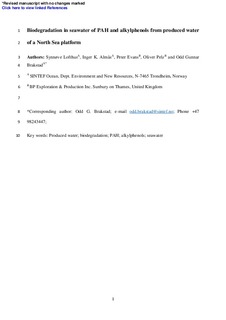Biodegradation in seawater of PAH and alkylphenols from produced water of a North Sea Platform
Journal article, Peer reviewed
Accepted version
Permanent lenke
http://hdl.handle.net/11250/2498689Utgivelsesdato
2018-09Metadata
Vis full innførselSamlinger
- Publikasjoner fra CRIStin - SINTEF Ocean [1312]
- SINTEF Ocean [1384]
Sammendrag
Operational planned discharges of produced water (PW) to the marine environment from offshore oil production installations, contain low concentrations of dispersed oil compounds, like polycyclic aromatic hydrocarbons (PAH) and alkylated phenols (APs). Biotransformation in natural seawater (SW) of naphthalene/PAH and phenol/AP in field-collected PW from a North Sea platform was investigated in this biodegradation study. The PW was diluted in SW from a Norwegian fjord, and the biodegradation study was performed in slowly rotating carousels at environmental conditions (13⁰C) over a period of 62 days. Naphthalene/PAH and phenol/AP biotransformation was determined by first-order rate kinetics, after normalization against the recalcitrant biomarker 17α(H),21β(H)-Hopane. The results from this study showed total biotransformation half-lives ranging from 10 to 19 days for groups of naphthalenes and PAH, while half-lives for APs (C0- to C9-alkylated) were 10 to 14 days. Biotransformation half-lives of single components ranged from 8 to >100 days for naphthalenes and PAHs (median 16 days), and from 6 to 72 days (median 15 days) for phenols and AP. Four of the tested PAHs (chrysene, benzo(b)fluoranthene, benzo(e)pyrene, benzo(g,h,i,)perylene) and one AP (4-tert-butylphenol) showed biotransformation half-lives >50 days. This is one of a few studies that has investigated the potential for biodegradation of PW in natural SW. Methods and data from this study may be used as a part of Risk Based Approaches (RBA) for assessments of environmental fate of PW released to the marine environment and as part of the persistence related to risk.

